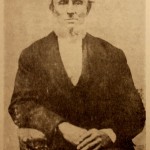Stotlar School was first a small boxed building that stood at the south edge of Herrin’s prairie. Now the large brick building familiarly known as the South Side School, though it was officially named Stotlar school in 1928, stands on the same ground within the city of Herrin. The land is that bought in 1855 by Samuel Stotlar (1813-1876) from David Herrin (1793-1870).
Samuel and Elizabeth (Parsons) Stotlar brought their children to Illinois in 1856. Their sons were Thomas, John Alexander, Christopher C., William Newton, James L., and Hiram Stotlar. Their daughter Zeruah Jane became the wife of Thomas Cox Jr.
Soon after the coming of this Ohio family, the old log schoolhouse that stood where White City park now stands was replaced by the boxed building that became known as the Stotlar School because Samuel Stotlar gave the land on which it was built. Yellow poplar from Crab Orchard was used for the lumber, dressed by hand, and the boards were tongued and grooved. The improved building called for better standards in teaching.
Among the early teachers was George W. Roberts, who was brought to Herrin’s prairie as an infant in 1839. He only had fourteen months’ schooling, but he found that he could teach by becoming the hardest student in his classes. All the Stotlar boys, the Herrin and Harrison children were his pupils. The schoolmaster married a granddaughter of the first Herrin to come to the prairie, made a home on a nearby farm, and continued his teaching during the winter terms though the farm chores had to be done by candlelight. His children attended Bandyville School.
Miss Ella Nora Denning came to board at Newton Bradley’s home and teach Stotlar School in 1863. She was the daughter of the leading merchant at Frankfort, part owner of the Galena lead mines. Miss Denning received an education unmatched by any of the girls who were her neighbors, for she studied three years in Catholic convents at Chicago and Dubuque. During the Christmas holidays she became the wife of George Sprague and moved to Eight Mile prairie where she was postmistress at Fredonia during her long widowhood.
C. C. (“Chris”) Stotlar finished Miss Denning’s school term.
In the days of the Civil war, Stotlar School was the meeting place for citizens of Herrin’s prairie. In its classroom the first churches since the days of old Rich Grove were organized and had their services. A Christian church and a Missionary Baptist church were organized there in 1864 and 1865. Samuel and Elizabeth Stotlar were among the charter members of the Christian Church, and their eldest son gave the land when a church was built just south of the school.
When the men came home from war, another generation took hold of Stotlar School. For twenty years, Thomas and James L. Stotlar were members of the school board. The third trustee was Ephraim Herrin, one of the founders of the city that would cover the prairie. This board paid ten or fifteen dollars more in salary than any district nearby, and had their choice of teachers in the county. A school election was the proof of the satisfaction they gave the district, for no one would come to vote until the trustees rang the school bell and each man started in a different direction to round up some voters.
Miss Maggie Kennedy from Fredonia and Mr. Lindel 0. Beans taught Stotlar school in the late seventies. Miss Emily Clementine Spiller taught the school from the fall of 1880 through the spring of 1883. She became the wife of Hiram Stotlar.
In 1884 William C. Rayburn of Carterville was employed to build a new schoolhouse a few yards northwest of the old building. This frame building had the door on the south instead of facing east as the old building did. Miss Mary Pope was the first teacher to preside from the platform at the north end of the room. She was a daughter of the miller of Herrin’s prairie and became the wife of Lum Benson; her son Joe was one of the first graduating class from Herrin high school.
The new school had a belfry, but no bell. Miss Pope had the customary exercises the last day of school and a small admission charge was made. The money bought a bell that is still rung every school day at South Side School. Mrs. William N. Stotlar, born Sarah Cox, and James Pike taught the succeeding terms.
Frank Joyner came from Stonefort to teach Stotlar School, and among his pupils were several who became teachers, John Herrin, Walter Williams, and Ed. M. Stotlar among them. Ed Roberts, son of the former teacher, produced some creditable poetry as part of his school work that term, but death ended his promise.
Mr. Joyner taught two years, 1886-1888, followed by William Wallace, then came, Miss Emmeline Pope, a sister of the first teacher in the building. Miss Pope, now Mrs. John Browning of Benton, taught three terms but Miss Jennie R. Hendrickson ruled the school one term while Miss Pope taught in Schoharie prairie.
Ed. M. Stotlar returned as teacher to the classroom where he had been pupil. His term was that of 1893-1894. Barney Ferrell and Miss Sarah Davis followed. Then the mines and railroad turned Herrin’s prairie into Herrin, and the country school became a city school.
(Extracted from Pioneer Folks and Places, Barbara Barr Hubbs, 1939 which is on sale at the Williamson County Museum)

